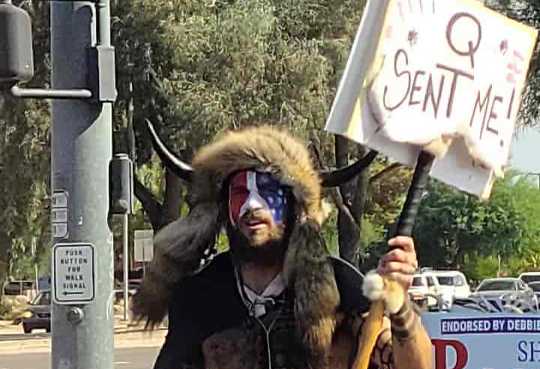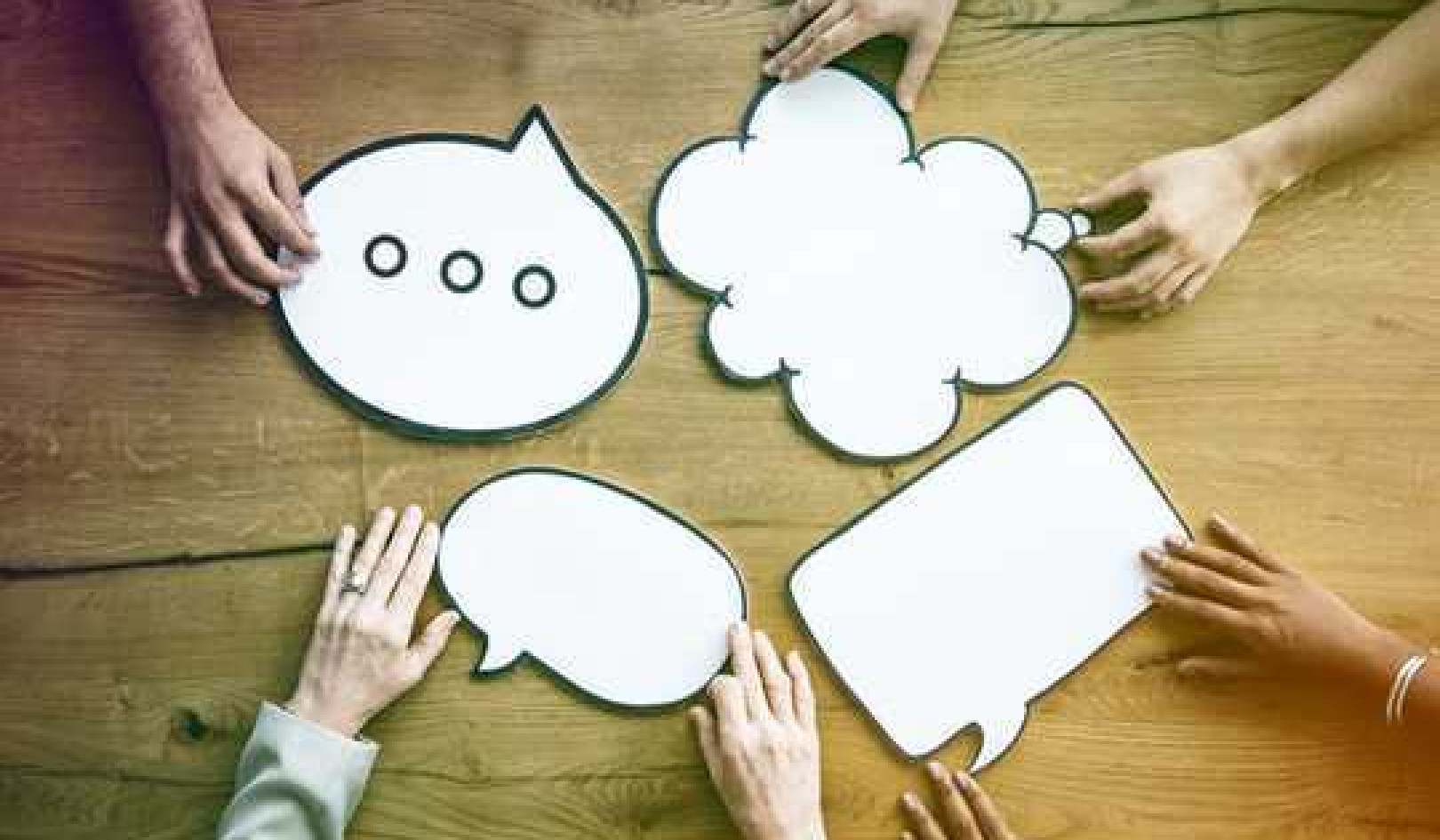Janet McIntosh.
The violent breach of the Capitol was a culmination of communication between President Trump and his most fanatical supporters, says linguistic anthropologist Janet McIntosh.
“The register of cryptic-yet-knowing talk among Trump supporters and Q aficionados helped inspire the insurrection.”
Before the crowd of thousands marched to the Capitol that day, they listened to a speech from President Donald Trump outside the White House for more than an hour.
What had they been saying? Why are these words important? McIntosh, professor at Brandeis University, and co-editor of the book Language in the Trump Era: Scandals and Emergencies (Cambridge University Press, 2020), explains:
Q
How have Trump’s supporters been talking about the election in recent weeks, and how did that play into the riots at the Capitol and other events around the country?
A
Since the results of the 2020 election, Trump’s most extreme supporters have been convinced the Democrats stole the election, and planning violence to reinstate him for another four years. Many have been hotly anticipating what they call “The Storm,” a grand, apocalyptic battle between Trump’s forces and evil liberal elements in the “Deep State.” The dynamic has been plain to see on social media for any of us who were curious, and watchdog groups reported this dynamic to the FBI.
Watching the social media accounts of so-called “Patriots,” one could see that many were entranced by “Q,” the mysterious supposed governmental insider with high-level security clearance who stokes wild “QAnon” conspiracy theories. Over the last couple of years, “Q-drop” messages, posted to message boards and circulated on social media, have grown more cryptic and tantalizing, even as Q repeatedly asks, “Do you believe in coincidences?” Patriots often feel affirmed by Q, along with Trump and Michael Flynn, his Q-enthusiastic former National Security Adviser, that they should be mobilizing in force.
Q
What are some examples of how QAnon followers and “Patriots” have been looking for these signals?
A
QAnon followers pore over Q’s enigmatic remarks and random-looking character strings. They have engaged in a kind of folk numerology, seeking correspondences between Q’s posts and Trump’s Twitter time stamps. They’ve tried to decrypt the first letters of each of Trump’s words, in relation to Q-drops. They’ve tried to divine how Trump and Michael Flynn might be speaking in code about the violence to come. Flynn himself repeatedly applauded Trump’s “digital army” for never giving up.
Some of Trump’s followers are fans of military cosplay in their signaling; after all, many are veterans, gun enthusiasts, and white supremacist militia members. When Steve Bannon recently uttered “Boom! Boom!” to make a point on a far-right talk show, enthusiasts repeated the phrase over and over, relishing the satisfying prospect of gunshots or explosions.
They intimated violence before January 6 with phrases like “Drop the hammer” and “Battle stations.” One frequent tweeter liked to post a “muster sign” for his followers, in the form of a single period. It served as a kind of roll call. Followers who typed a single period in response signaled they’re still at the ready, in the digital army. His Twitter account, like that of many on the extreme right, has since been closed.
Q
When did this language start to become evident?
A
The general patterns I’m describing have been ramping up for a couple of years, but social media chatter among these extremists took on an especially foreboding, apocalyptic quality after the November elections. “Stay Calm. The Storm comes.” “Pay attention.” “Buckle up.” “You’re going to love how this movie ends.” “Nothing can stop what’s going to happen. Nothing.”
Supporters fervently hoped Trump would make a big move, declaring martial law to halt the election process and stage a re-vote. When each oracular prediction failed to come through, they would reassure one another Trump was still “5 steps ahead” or “playing 6D chess,” urging one another to “Trust the plan.”
Q
There is a lot of implied secrecy in QAnon messaging. Why is this important?
A
The register of cryptic-yet-knowing talk among Trump supporters and Q aficionados helped inspire the insurrection. Secrecy gives the impression of power, stoking confidence in the cause. Encryption suggests the sinister forces Q refers to—the “Deep State” and other corruptions of the depraved elite— can only be grasped in fragmentary form by mere mortals, because the full truth of liberal evil, and Trump’s brilliant schemes to save the nation, would be too big to handle. Confident statements like “Nothing can stop what’s coming,” inspire bravado, yet they are flexible in response to disappointment since they don’t state precisely what will come when. But many Trump oracles were pleased that on January 6, prophecies were fulfilled. When journalists referred to them as “storming” the Capitol, it affirmed that “The Storm”—the start of it, anyway—had arrived.
Q
You previously explained some of Trump’s “racist dog whistles.” Did he –or any Trump-loyal politicians—use dog whistles to incite the rioters? Are these new or are they things he has been saying all along?
A
So, a “dog whistle” is a word or phrase that has subtle or distinctive meaning—such as invoking a prejudicial back story—to a particular audience. Over the years Trump’s racist dog whistles did their part in ensuring a white supremacist base, who turned out in force on January 6.
Since the November election, Trump has found new dog whistles. The phrase “Stop the Steal,” for instance, has special resonance for his followers because for years Trump has stoked the idea that racial minorities are “stealing” from “decent” (white) Americans; that immigrants are pouring in to plunder the nation; that African Americans are garnering jobs and other privileges from “reverse racism,” and so forth.
He’s persuaded his base they have been “stolen from” for a long time, stoking what sociologist Michael Kimmel calls a sense of “aggrieved entitlement.” Now, Trump had a high-stakes election to attach this grievance to, and it is no coincidence that the votes he has questioned are disproportionately those of minority voters. “Stop the Steal” has special power because it emerges from the broader narrative that unentitled minorities have been “stealing” from what is supposedly rightfully that of Trump’s base.
On December 19, Trump issued several tweets to promote the January 6 event, including: “Big protest in D.C. on Jan. 6. Be there, will be wild!”—a descriptor implying norms would be violated or rules broken. Some of Trump’s supporters evidently took him as enlisting their help, rather like a paramilitary force. On January 1, for instance, a supporter tweeted that “The calvary [sic] is coming, Mr. President!” Trump affirmed this as “A great honor!”
Other Republicans were more direct in encouraging violence. After another court rejected Trump’s election appeal on January 2, Rep. Louie Gohmert appeared on Newsmax and said, “you have to go to the streets and be …violent.”
Q
Did Trump incite his crowd to violence on January 6?
A
On January 6, Trump gave a 70-minute speech to the crowd assembled at the Ellipse near the White House. He rambled at length about the details surrounding the supposed election steal, sounding chaotic and deluded to critics.
Yet, to his followers, his ability to reel off statistics, however false, not only evoked his ostensible business expertise but also furnished more evidence for the stolen election. Trump also made numerous statements that could be taken as a call to insurrection: “If you don’t fight like hell, you’re not going to have a country anymore;” “When you catch somebody in a fraud, you’re allowed to go by very different rules;” “You’ll never take back our country with weakness.”
The implication of the word “our” is that America has fallen into the wrong hands: Democrats, minorities, and urban elites. When his supporters chanted “Fight for Trump,” he responded with the approving “Thank you.”
Trump made a passing suggestion that the afternoon’s protest should be nonviolent, saying, “I know that everyone here will soon be marching over to the Capitol building to peacefully and patriotically make your voices heard.”
The statement—later quoted by his lawyer Rudy Giuliani—offered him the sort of legalistic plausible deniability he wants to wiggle out of the charge that he incited a riot. Perhaps down the road he will also claim he was using words like “fight” metaphorically. Giuliani will have to pull a similar move about his own statement that the crowd should engage in “trial by combat.”
Regardless of what Trump will claim he meant, journalists overheard rioters saying things like “This is what Trump wants.” In speech act theory, we talk about the “perlocutionary effect” of utterances—their practical effects. The perlocutionary effect of Trump’s words was a violent insurrection.
Q
In Trump’s video message during the insurrection, he lied about the election being “stolen;” he told the people invading the Capitol, “We love you; you’re very special,” while also asking them to “Go home in peace.” What is he doing here?
A
It’s classic Trump, having it both ways. History will likely show that Trump’s advisors wheedled him into making a gesture of damage control, so he told the rioters to go home. Yet he simultaneously doubled down on the “Stop the Steal” cause, reminding his base he’s been egregiously robbed. And his statement that “We love you; you’re very special”—the register of a parent speaking to a beloved child—would be hilarious if it weren’t so tragic.
Trump would never say such a thing to BLM demonstrators, or protesters objecting to the Kavanaugh hearings. If he’s called on the carpet for that profession of love, I won’t be surprised if he claims he was heroically trying to mollify an angry crowd to save lives. Trump has mastered the skill of plausible deniability.
About the Author
Interview with Janet McIntosh, professor at Brandeis University, and co-editor of the book Language in the Trump Era: Scandals and Emergencies (Cambridge University Press, 2020)

Related Books:
On Tyranny: Twenty Lessons from the Twentieth Century
by Timothy Snyder
This book offers lessons from history for preserving and defending democracy, including the importance of institutions, the role of individual citizens, and the dangers of authoritarianism.
Click for more info or to order
Our Time Is Now: Power, Purpose, and the Fight for a Fair America
by Stacey Abrams
The author, a politician and activist, shares her vision for a more inclusive and just democracy and offers practical strategies for political engagement and voter mobilization.
Click for more info or to order
How Democracies Die
by Steven Levitsky and Daniel Ziblatt
This book examines the warning signs and causes of democratic breakdown, drawing on case studies from around the world to offer insights into how to safeguard democracy.
Click for more info or to order
The People, No: A Brief History of Anti-Populism
by Thomas Frank
The author offers a history of populist movements in the United States and critiques the "anti-populist" ideology that he argues has stifled democratic reform and progress.
Click for more info or to order
Democracy in One Book or Less: How It Works, Why It Doesn't, and Why Fixing It Is Easier Than You Think
by David Litt
This book offers an overview of democracy, including its strengths and weaknesses, and proposes reforms to make the system more responsive and accountable.























